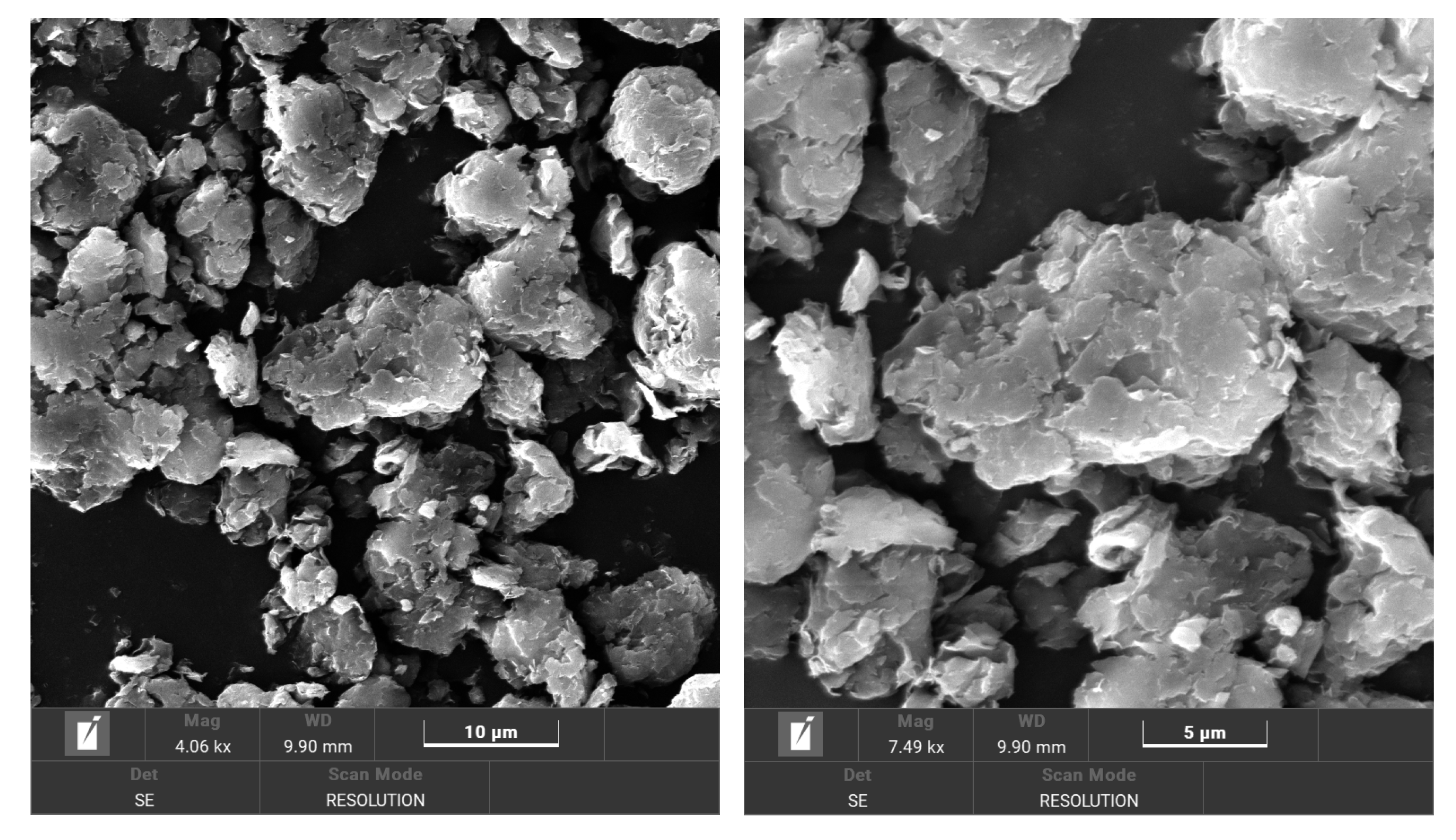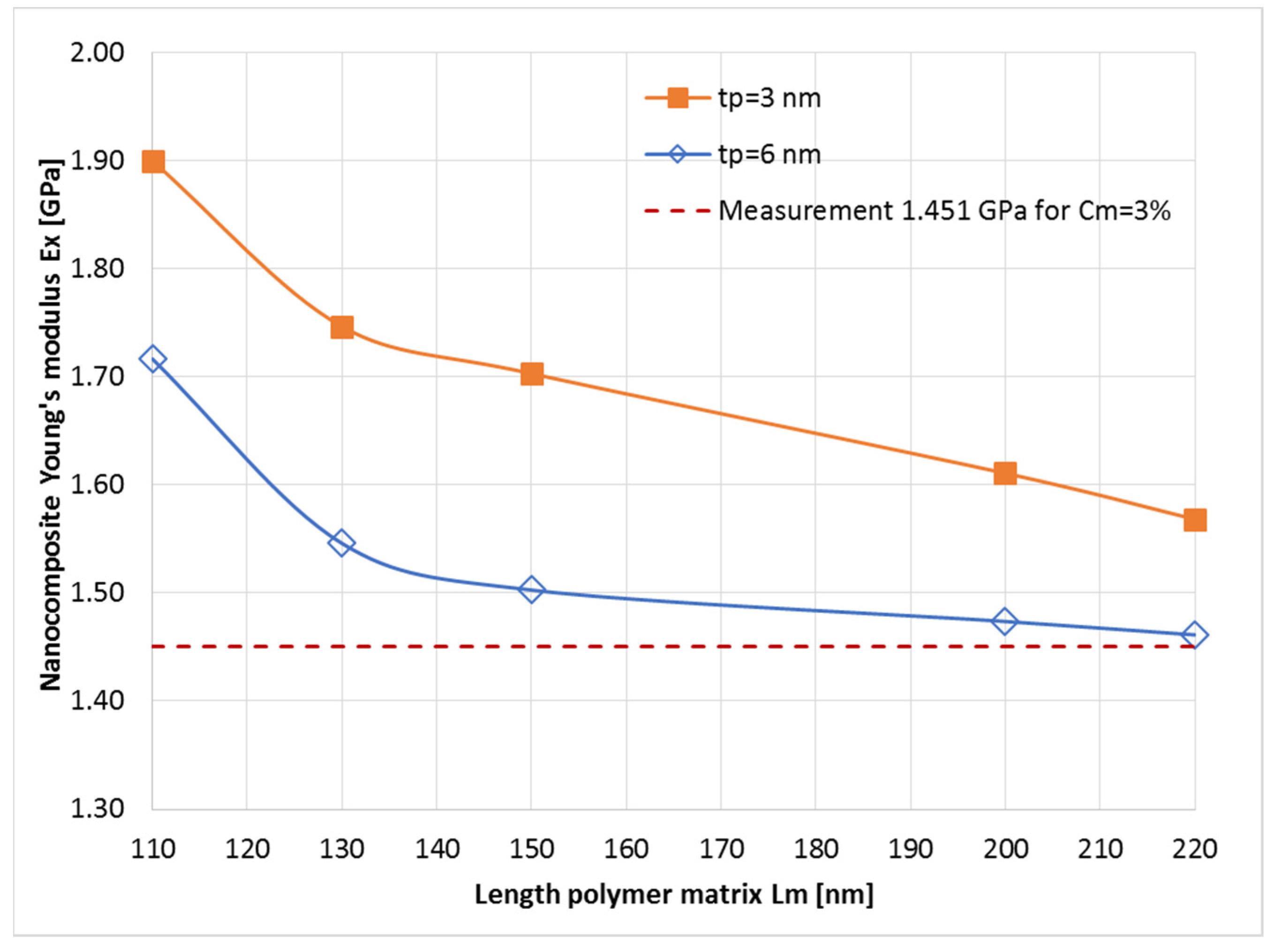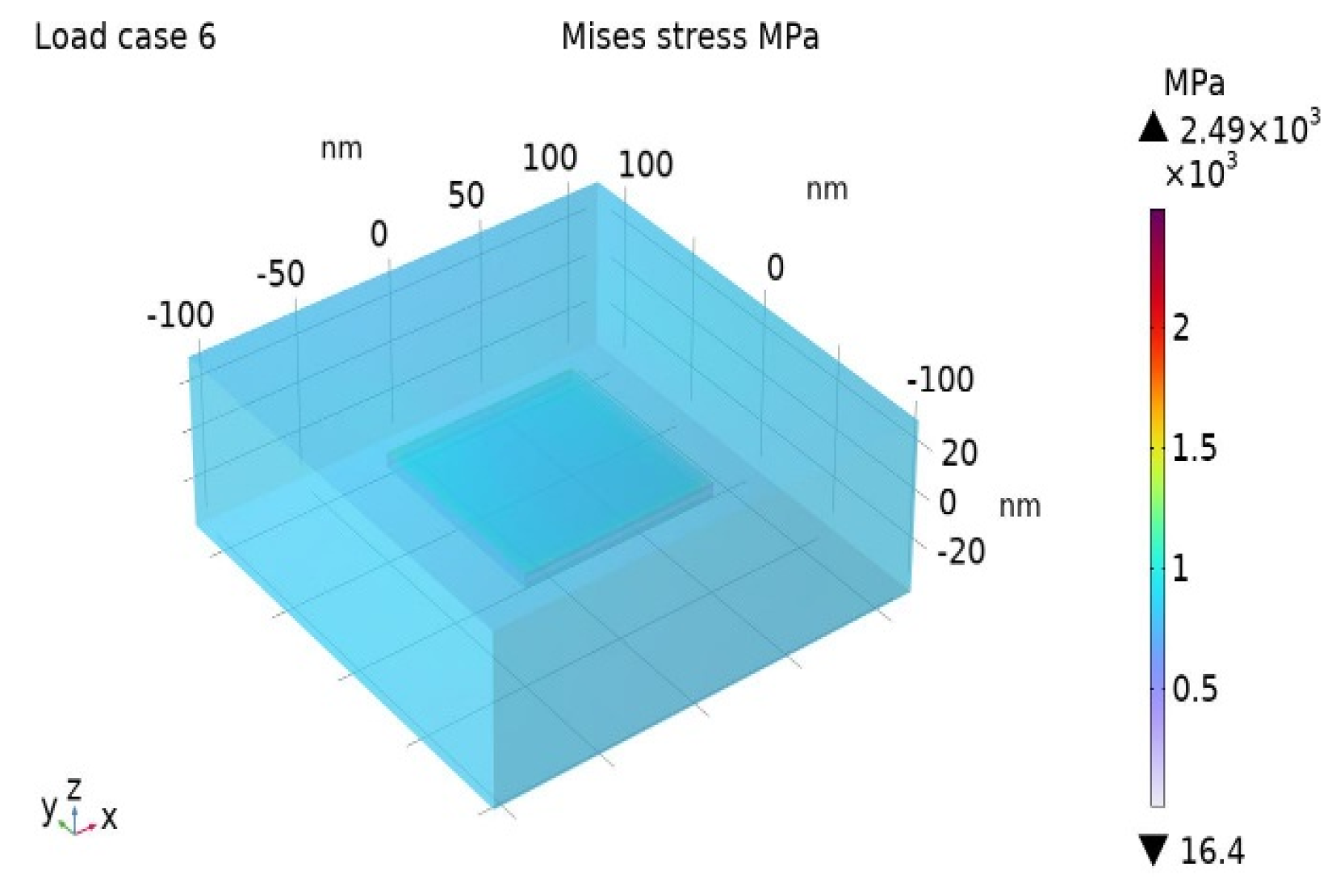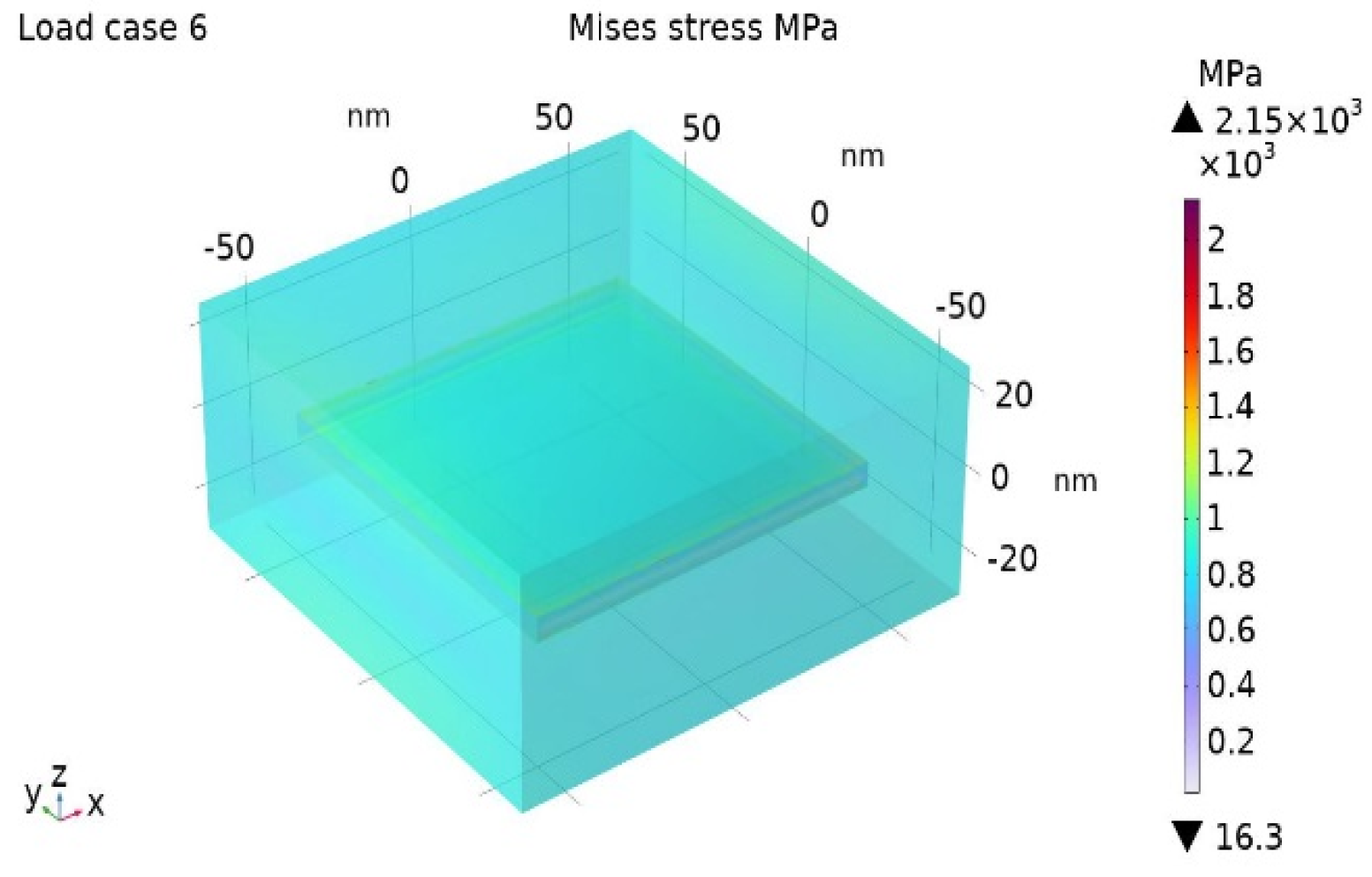Prediction of Mechanical Properties of Nano-Clay-Based Biopolymeric Composites
Abstract
:1. Introduction
2. Materials and Methods
2.1. Materials
2.2. Nanocomposite Preparation
2.3. Tensile Properties of Nanocomposites
2.4. Modeling of the Nancomposite Material
3. Results
3.1. Young’s Modulus Measurements
3.2. Modeling Results
4. Discussion and Conclusions
Author Contributions
Funding
Data Availability Statement
Acknowledgments
Conflicts of Interest
References
- Zare, Y.K.; Yop, R. Simulation of Young’s modulus for clay-reinforced nanocomposites assuming mechanical percolation, clay-interphase networks and interfacial linkage. J. Mater. Res. Technol. 2020, 9, 12473–12483. [Google Scholar] [CrossRef]
- Alasfar, R.H.; Ahzi, S.; Barth, N.; Kochkodan, V.; Khraisheh, M.; Koç, M. A Review on the Modeling of the Elastic Modulus and Yield Stress of Polymers and Polymer Nanocomposites: Effect of Temperature, Loading Rate and Porosity. Polymers 2022, 14, 360. [Google Scholar] [CrossRef] [PubMed]
- Uddin, M.N.; Hossain, M.T.; Mahmud, N.; Aalm, S.; Joaber, M.; Mahedi, S.I.; Ali, A. Research and applications of nanoclays: A review. SPE Polym. 2024, 1–29. [Google Scholar] [CrossRef]
- Shubham, S.K.; Purohit, R.; Yadav, P.S.; Rana, R.S. Study of nano-fillers embedded in polymer matrix composites to enhance its properties—A review. Mater. Today Proc. 2020, 26, 3024–3029. [Google Scholar] [CrossRef]
- Bakis, G.; Kothmann, M.H.; Zeiler, R.; Brückner, A.; Ziadeh, M.; Breu, J.; Altstädt, V. Influence of size, aspect ratio and shear stiffness of nanoclays on the fatigue crack propagation behavior of their epoxy nanocomposites. Polymer 2018, 158, 372–380. [Google Scholar] [CrossRef]
- Maiti, M.; Mitra, S.; Bhowmick, A.K. Effect of nanoclays on high and low temperature degradation of fluoroelastomers. Polym. Degrad. Stab. 2008, 93, 188–200. [Google Scholar] [CrossRef]
- Gu, A.; Liang, G. Thermal degradation behaviour and kinetic analysis of epoxy/montmorillonite nanocomposites. Polym. Degrad. Stab. 2003, 80, 383–391. [Google Scholar] [CrossRef]
- Chen, B. Polymer–clay nanocomposites: An overview with emphasis on interaction mechanisms. Br. Ceram. Trans. 2004, 103, 241–249. [Google Scholar] [CrossRef]
- Chiu, C.-W.; Huang, T.-K.; Wang, Y.-C.; Alamani, B.G.; Lin, J.-J. Intercalation strategies in clay/polymer hybrids. Prog. Polym. Sci. 2014, 39, 443–485. [Google Scholar] [CrossRef]
- Rafiee, R.; Shahzadi, R. Mechanical Properties of Nanoclay and Nanoclay Reinforced Polymers: A Review. Polym. Compos. 2019, 40, 431–445. [Google Scholar] [CrossRef]
- Arora, B.; Bhatia, R.; Attri, P. Bionanocomposites: Green materials for a sustainable future. In New Polymer Nanocomposites for Environmental Remediation; Elsevier: Amsterdam, The Netherlands, 2018; pp. 699–712. [Google Scholar] [CrossRef]
- Joseph, B.; Krishnan, S.; Sagarika, V.K.; Tharayil, A.; Kalarikkal, N.; Thomas, S. Bionanocomposites as industrial materials, current and future perspectives: A review. Emergent Mater. 2020, 3, 711–725. [Google Scholar] [CrossRef]
- Zazoum, B.; Triki, E.; Bachri, A. Modeling of Mechanical Properties of Clay-Reinforced Polymer Nanocomposites Using Deep Neural Network. Materials 2020, 13, 4266. [Google Scholar] [CrossRef] [PubMed]
- Doagou-Rad, S.; Jensen, J.S.; Islam, A.; Mishnaevsky, L. Multiscale molecular dynamics-FE modeling of polymeric nanocomposites reinforced with carbon nanotubes and graphene. Compos. Struct. 2019, 217, 27–36. [Google Scholar] [CrossRef]
- Rafiee, R.; Shahzadi, R. Predicting mechanical properties of nanoclay/polymer composites using stochastic approach. Compos. Part B Eng. 2018, 152, 31–42. [Google Scholar] [CrossRef]
- Odegard, G.M.; Clancy, T.C.; Gates, T.S. Modeling of the mechanical properties of nanoparticle/polymer composites. Polymer 2005, 46, 553–562. [Google Scholar] [CrossRef]
- UNE-EN ISO 1183-1:2019; Plastics–Methods for Determining the Density of Non-Cellular Plastics–Part 1: Immersion Method, Liquid Pycnometer Method and Titration Method. ISO: Geneva, Switzerland, 2019.
- ISO 11357-1:2023; Plastics—Differential Scanning Calorimetry (DSC). Part 1: General Principles. ISO: Geneva, Switzerland, 2023.
- ISO 527-1:2019; Plastics—Determination of Tensile Properties. Part 1: General Principles. ISO: Geneva, Switzerland, 2019.
- Hughes, E.J.; Rutherford, J.L. Determination of Mechanical Properties of Polymer Film Materials. NASA Report No. KD 75-9, Contract No. 953959; Singer: Little Falls, NJ, USA, 1975. Available online: https://ntrs.nasa.gov/api/citations/19760015291/downloads/19760015291.pdf (accessed on 1 May 2023).
- COMSOL Multiphysics® v. 6.1. COMSOL AB, Stockholm, Sweden. Available online: https://cn.comsol.com/ (accessed on 1 May 2023).
- Subburamamurthy, H.B.; Rathanasamy, R.; Kumar, H.K.M.; Chinnasamy, M.; Kaliyannan, G.V.; Natarajan, S. Improvement of the mechanical and damping behavior of nylon by integration of nanoclay platelets. Mater. Test. 2021, 63, 1124–1129. [Google Scholar] [CrossRef]
- Martey, S.; Jamalzadeh, M.; Chen, W.-T.; Sobkowicz, M.J. The role of nanoclay in processing immiscible polypropylene and poly (ethylene terephthalate) waste blends using twin screw extrusion. Compos. Part B Eng. 2024, 276, 111320. [Google Scholar] [CrossRef]
- Kausar, A.; Ahmad, I.; Maaza, M.; Eisa, M.H. State-of-the-Art nanoclay reinforcement in green polymeric nanocomposite: From design to new opportunities. Minerals 2022, 12, 1495. [Google Scholar] [CrossRef]







| Screw Configuration | Formulations of Nanocomposites | ||
|---|---|---|---|
| Screw 1 | BioPA11_0 wt% Nano-clays | BioPA11_3 wt% Nano-clays | BioPA11_10 wt% Nano-clays |
| Screw 2 | BioPA11_0 wt% Nano-clays | BioPA11_3 wt% Nano-clays | BioPA11_10 wt% Nano-clays |
| Screw 3 | BioPA11_0 wt% Nano-clays | BioPA11_3 wt% Nano-clays | BioPA11_10 wt% Nano-clays |
| Geometry Dimension | Abbreviation | Unit [nm] |
|---|---|---|
| Length of the polymer matrix volume element | Varied between 110 nm and 220 nm | |
| Thickness of the polymer matrix volume element | Varied as function of mass concentration, Cm%, and | |
| Length of the flake | 100 nm × 100 nm | |
| Thickness of the flake | Varied between 1 nm and 9 nm |
| BioPA11_0 wt% Nano-Clays | BioPA11_3 wt% Nano-Clays | BioPA11_10 wt% Nano-Clays | |||
|---|---|---|---|---|---|
| Screw Configur. | Young’s Modulus (MPa) | Young’s Modulus (MPa) | Increm. (%) * | Young’s Modulus (MPa) | Increm. (%) * |
| Screw 1 | 1219 ± 22 | 1344 ± 8 | 10.3 | 2023 ± 19 | 66.1 |
| Screw 2 | 1205 ± 17 | 1435 ± 18 | 19.1 | 2090 ± 22 | 73.4 |
| Screw 3 | 1192 ± 19 | 1451 ± 15 | 21.7 | 2298 ± 56 | 92.8 |
Disclaimer/Publisher’s Note: The statements, opinions and data contained in all publications are solely those of the individual author(s) and contributor(s) and not of MDPI and/or the editor(s). MDPI and/or the editor(s) disclaim responsibility for any injury to people or property resulting from any ideas, methods, instructions or products referred to in the content. |
© 2024 by the authors. Licensee MDPI, Basel, Switzerland. This article is an open access article distributed under the terms and conditions of the Creative Commons Attribution (CC BY) license (https://creativecommons.org/licenses/by/4.0/).
Share and Cite
Voicu, R.C.; Gologanu, M.; Tibeica, C.; Santiago-Calvo, M.; Asensio, M.; Cañibano, E.; Nedelcu, O.; Sandu, T. Prediction of Mechanical Properties of Nano-Clay-Based Biopolymeric Composites. Nanomaterials 2024, 14, 1403. https://doi.org/10.3390/nano14171403
Voicu RC, Gologanu M, Tibeica C, Santiago-Calvo M, Asensio M, Cañibano E, Nedelcu O, Sandu T. Prediction of Mechanical Properties of Nano-Clay-Based Biopolymeric Composites. Nanomaterials. 2024; 14(17):1403. https://doi.org/10.3390/nano14171403
Chicago/Turabian StyleVoicu, Rodica Cristina, Mihai Gologanu, Catalin Tibeica, Mercedes Santiago-Calvo, María Asensio, Esteban Cañibano, Oana Nedelcu, and Titus Sandu. 2024. "Prediction of Mechanical Properties of Nano-Clay-Based Biopolymeric Composites" Nanomaterials 14, no. 17: 1403. https://doi.org/10.3390/nano14171403






